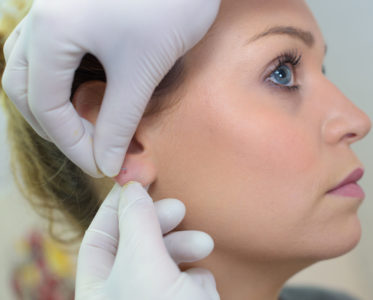 Nobody wants to have to deal with a headache, or worse, a migraine, but oftentimes patients feel helpless to control and prevent their onset. Some people have found that improvements to daily exercise and dietary habits can help a little, but others can’t seem to find treatment success no matter what route they pursue.
Nobody wants to have to deal with a headache, or worse, a migraine, but oftentimes patients feel helpless to control and prevent their onset. Some people have found that improvements to daily exercise and dietary habits can help a little, but others can’t seem to find treatment success no matter what route they pursue.
One treatment option that we’ve recommended in the past for patients who have failed to find relief with more standard treatment options is the Daith piercing. It involves piercing part of the cartilage in a person’s ear in order to stimulate that vagus nerve. As we’ve talked about in previous blogs, stimulating the vagus nerve may increase parasympathetic activity and decrease excessive sympathetic activity in the region, which would likely decrease the vascular events that surround migraine headaches.
Now, it’s worth noting that our understanding of the inner workings of vagus nerve stimulation is still in its infancy. In fact, the first handheld non-invasive electrical vagus nerve stimulating device only recently received FDA clearance, but it’s a huge step in the right direction in terms of helping people find the right way to prevent and treat their headaches. In our understanding, there certainly appears to be a correlation between vagus nerve stimulation and certain headache relief, but we need to better understand the science between these connections. Simply put, we’re not saying that this is a perfectly wonderful and clinically-proven treatment option for headaches. What we will say is that we’ve seen it work for a number of patients.
Why Consider Daith
When it comes to considering the Daith piercing to help control your headaches, it really comes down to a value proposition. Many patients have spent thousands of dollars on treatments that haven’t proven successful, so when they hear about the Daith piercing, it’s often viewed as a relatively low-risk option from a cost standpoint. The piercing can run anywhere from $30-$100 and you’ll want to find someone with specific Daith piercing experience to place the piercing in the right spot, but it’s often far cheaper than other headache treatment options, so for many it’s worth consideration.
If you’re battling frequent headaches and you’ve tried other options, consider reaching out to a pain management specialist to learn more about vagus nerve stimulation. Some patients have even found some relief by gently massaging their ear in the location of the vagus nerve (see the center piercing in the photo for the correct location) when they feel a headache coming on. Try massaging one side and then work on the other ear. If massaging one side seems to help, that may be the ear to get the piercing in.
At the end of the day, we can’t reiterate enough that this treatment isn’t fully researched and shouldn’t be your first option. However, our goal as clinicians is to help our patients find pain relief, and if other treatments have failed, maybe vagus nerve stimulation is something to consider. You have a lot to gain and little to lose, and we’d be more than happy to go into more specifics during a pain management appointment. We can’t perform the piercing and we don’t refer you to any piercers in the area, but we can talk about the connection between nerve stimulation and headache relief. We may recommend other options, but we want to do what’s right for you. Whether that’s in the form of hands-on treatment or patient education, we want to help you find a solution to your headaches. Give our office a call today if you’ve been battling chronic headaches or migraines.
 Daith piercings have been showing success in helping to control migraine headaches. Now there is new research that seems to shine more light on what has been thought to be the mechanism that contributes to the success of this treatment. Research into dementia has recently been done with stimulating the ear with a slight bit of external and intermittent vibration. The research suggests that this may help prevent dementia. The mechanism of action is thought to be by stimulating the ear, a branch of the vagus nerve is also being affected and this is what is producing the results. Similar to what we assumed was happening with the
Daith piercings have been showing success in helping to control migraine headaches. Now there is new research that seems to shine more light on what has been thought to be the mechanism that contributes to the success of this treatment. Research into dementia has recently been done with stimulating the ear with a slight bit of external and intermittent vibration. The research suggests that this may help prevent dementia. The mechanism of action is thought to be by stimulating the ear, a branch of the vagus nerve is also being affected and this is what is producing the results. Similar to what we assumed was happening with the  The following is a guest post from Leticia, a reflexologist and state certified piercer. She reached out to us with some more information on the
The following is a guest post from Leticia, a reflexologist and state certified piercer. She reached out to us with some more information on the  As you’re probably aware if you
As you’re probably aware if you